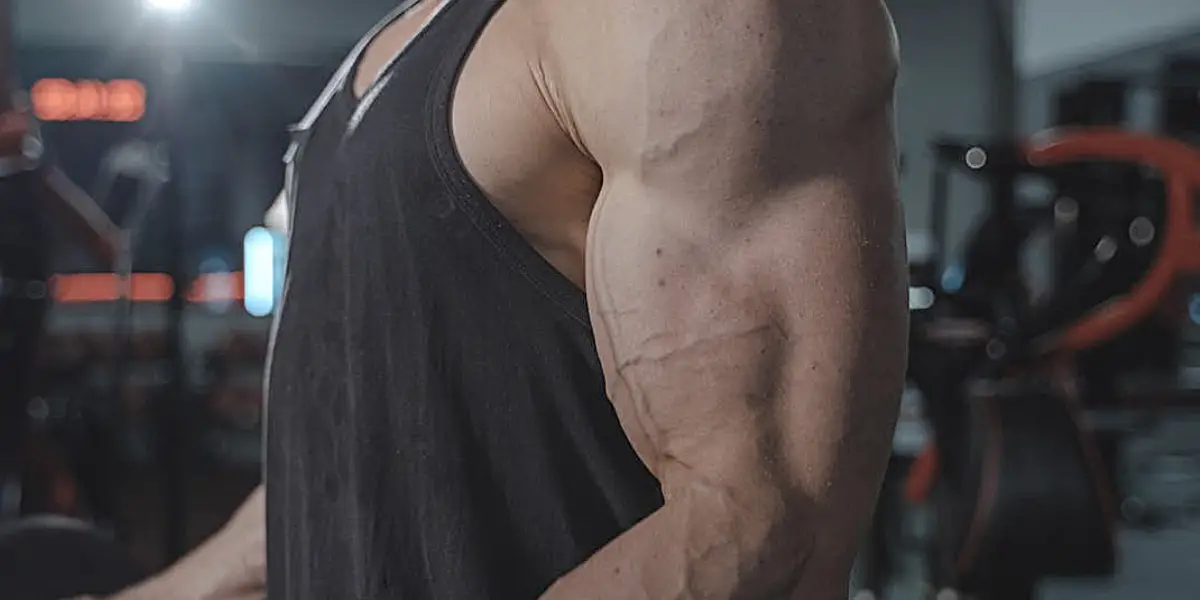Anyone who spends a fair amount of time lifting weights will tell you that at least half, if not more, of lifting in the gym is mental. If there is one thing a muscle pump will give you, it’s a mental boost.
It’s the kind of thing that gets your mind into the workout, which is exactly where it needs to be. But how long does muscle pump last? Is there any benefit to it, and how can you make it last longer?
The vein-popping, shredded look that a muscle pump gives you will last between 2 and 3 hours after you drop the last weight for the day. Your blood and oxygen-saturated muscles will remain that way until everything settles back into normalcy.
Isolation exercises will make the pump last even longer, plus a solid level of hydration and plenty of carbs. A good muscle pump leads to a higher degree of muscle growth over time. The blood and oxygen forced into the muscles also carry muscle-repairing nutrients.
The swelling from a muscle pump can knock protein synthesis into gear to stimulate muscles to reinforce their fibers. The outcome is stronger and bigger muscles if done correctly.
Things That Affect Muscle Pump
It’s not just your attitude that affects muscle pump in the gym, though attitude is huge, starting from the moment you first walk in the doors. The most immediate bodily reaction that causes muscle pump is the flood of water (blood) to the muscle tissues you’re working on.
Oxygen and nutrients are everything, and that’s what water brings. As you lift, you’re making microscopic tears in the fiber of the muscles. Those tears need to be isolated and repaired. Of course, this is the main effect on muscle growth—repairing the tissue bigger and stronger than before.
If you drink plenty of water (and especially if you take creatine). In that case, the amount of blood flowing to the working muscles is excessive. It can create a bulging, larger-looking muscle. There are other factors at work, mainly depending on how you prep each day.
- Isolation exercises bring out the best muscle pump
- Shorter rest periods between sets
- Your daily carbohydrate intake
- How well you are hydrated
- Muscle pump supplements
- Supersets and drop sets
- Maintain tension
Isolation Exercises
Isolation exercises are the most potent muscle pump exercises you can engage in. Deadlifting and powerlifting just aren’t going to get it done. The muscle you’re working on doesn’t matter, so long as you’re isolating it with 3 sets of 10 or 8, including curls, hammer curls, rows, skull crushers, crunches, raises, and flies.
Isolation exercises extend the duration of a good muscle pump. Since you’re focusing on one muscle, you’re telling your body to flood that location with blood and oxygen until it’s engorged.
Hydrate Well
Your body can’t afford to send too much water to isolated muscle groups if all you chug is NOS and Coors Light all day. On the other hand, your body is a shade over 60% water, so it obviously needs water to replenish your losses.
Don’t replenish water with junk. Plain water is best.
The general consensus from numerous health gurus is that the average person should consume 8 glasses of water daily. But, of course, if you’re working out extensively, you may want to add a glass or two on top of that.
Drop Sets
Drop sets are standard enough that you should be familiar with them. They’re also excellent for pumping blood, water, and oxygen to isolated muscle groups. Start with your maximum weight for a 3 set of 8 or 10.
Once you hit the last rep, drop 25% to 30% of the weight and immediately pick them back up for another go. Keep going until you can barely lift. The point is to physically exhaust the muscle so that nothing is left.
Keep good form, though. Don’t risk injury.
You’ll feel it in the morning, and drop sets are something you should do only in some workout sessions. However, they’re good to do now and then, especially if you’re going for that ripped, pumped look in the mirror.
Super Sets
Super sets are achieved by jumping back and forth between two muscle groups with no break in between. For instance, if it’s arm day, rip through a set of standard curls until you reach your last rep, then quickly switch over to skull crushers and work your triceps through a set of 8.
Rinse and repeat with the ultimate goal of (like drop sets) exhausting your muscle groups. The only break each muscle group gets is when you switch to the other and complete a set, then it’s back again.
Keep the Tension Up
A part of each rep is more than just lifting the weight against gravity. It’s squeezing the muscle you’re working as hard as you can throughout the entire motion. You’re doing this through tension, and it’s the same principle you use when flexing.
In fact, think of it as just that—flexing while you’re working your way through your reps. Keep the tension up and going as you lower the weight.
Control the weight on the way down – nice and slow.
Its more difficult to do since your instinctive reaction is to release when you drop the weight.
However, you should be working against the resistance of the weight even as you lower it for more productive results.
Protein and Carbohydrates
If you are trying to build muscle. It would be best if you had a lot of protein. Whatever your weight, you should 1.5 to 2 that in grams of protein intake each day. If you weigh 212 pounds, your protein intake should be 424 grams daily.
Sounds easy enough, right? It’s not that simple.
Those 424 grams of protein are much more than you think they are. Two cans of tuna fish are loaded with protein and they will make two, very large sandwiches.
However, that only totals 40g of protein with only 384g to go. One serving size of whey protein powder is about 24g of protein.
It’s a lot of protein, which means thoroughly restructuring your diet. It’s not easy either, especially if you have a family who may want or need less protein than you do. However, carbs are also essential, and you should consume 2 to 3 grams of carbs per pound of body weight each day.
Carbs come before (2 hours or more prior) working out and after. Your body needs the fuel, and the more fuel and repair nutrients you provide, the more the pump will last at the end of each lift.
Muscle Pumping Supplements
Otherwise known as vasodilators, muscle-pumping supplements open up and dilate your blood vessels, which helps to create that pumped look you’re going for. Supplements such as L-arginine or L-citrulline work to increase the blood flow through your body.
Regular old fish oil or omega-3s are great at increasing your blood flow as well. Of course, the number one supplement for most lifters these days is creatine. Creatine works by flooding more water into the muscle.
You can practically tell the difference between someone using creatine with someone whole isn’t when they’re standing side by side, going through the same workout routine. It makes that much of a difference.
Does a Muscle Pump Mean You Had a Good Workout?
Not necessarily. A good pump doesn’t mean anything either way. You can be energy and nutrient deficient and get a good pump throughout your workout. Your muscles simply respond that way—tightening around and constricting your blood vessels and flooding with blood.
If that blood isn’t bringing what you need and you’re not getting optimal nutrition, you will probably notice the effect on your workout anyway. You just won’t gain much from it.
You’ll be more fatigued, lack mental focus, and lack the willpower to see it through.
All of the above things that aid and extend muscle pumps are necessary for a “good workout.” Without them, you will notice the difference. Hypertrophy workouts necessitate proper body fuel and 3 or 4 sets of between 8 and 12 reps (weights appropriate to your current strength level).
Why Does Muscle Pump Fade in Two to Three Hours?
Think about it this way—your muscles can’t remain that tight and constrictive on your blood vessels forever. If they did, you would have some serious problems down the road.
As your muscle fibers heal and are fed the proper amounts of oxygen, blood, and nutrients, the need for that level of tension fades.
As the muscle starts to relax and loosen up, the blood vessels become less and less constricted. As a result, any remaining water and glucose will slowly get absorbed by your muscles while they relax.
Fortunately, you get to determine how long your muscle pump lasts by eating right and being adequately hydrated up until, throughout, and after your workout session. If you are undereating and not drinking the right amount of water each day, you will not get much of a muscle pump anyway.
Crossfit training, circuit training, deadlifts, power raises, and things of that nature aren’t going to induce much of a muscle pump either. So how you work out is as essential as the fuel you provide your body. Your mentality makes a difference as well. ‘
All Things Considered
Muscle pump generally lasts 2 to 3 hours post-workout. However, it’s conditional. In order t get the muscle pump you are looking for, you need to train right. This includes proper nutrition and supplementation. You can look forward to splitting those sleeves after your workout if you get that right.
References and Citations
Matthews, M. (N/A). Hypertrophy Training: Best Workout Program for Hypertrophy
Retrieved from: https://legionathletics.com/hypertrophy-training-workout-program/
Kreider, R.B., Kalman, D.S., Antonio, J. et al. International Society of Sports Nutrition position stand: safety and efficacy of creatine supplementation in exercise, sport, and medicine. J Int Soc Sports Nutr 14, 18 (2017). https://doi.org/10.1186/s12970-017-0173-z
C.S.C.S., T. T. (2021, November 2). Why you really want to focus on your muscle pump. Men’s Health. Retrieved November 7, 2022, from https://www.menshealth.com/fitness/a19520337/muscle-pump-builds-size-and-strength/
- 5 Best Power Towers For Your Home Gym - July 19, 2023
- What Does Natty Mean in Body Building? Is It Good or Bad? - June 26, 2023
- How Much Creatine Is In Bang? The Amount Might Surprise You - June 25, 2023

